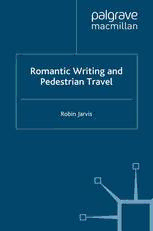
Romantic Writing and Pedestrian Travel PDF
Preview Romantic Writing and Pedestrian Travel
ROMANTIC WRITING AND PEDESTRIAN TRAVEL Also by Robin Jarvis WORDSWORTH, MILTON AND THE THEORY OF POETIC RELATIONS REVIEWING ROMANTICISM (with Philip W. Martin) Rotnantic Writing and Pedestrian Travel Robin Jarvis Head of Literary Studies University of the West of England, Bristol First published in Great Britain I 997 by MACMILLAN PRESS LTD Houndmills, Basingstoke, Hampshire RG2 I 6XS and London Companies and representatives throughout the world A catalogue record for this book is available from the British Library. ISBN 978-0-333-79460-9 ISBN 978-0-230-37136-1 (eBook) DOI 10.1057/9780230371361 First published in the United States of America 1997 by ST. MARTIN'S PRESS, INC., Scholarly and Reference Division, 175 Fifth Avenue, New York, N.Y. 10010 ISBN 978-0-312-17531-3 Library of Congress Cataloging-in-Publication Data Jarvis, Robin, I 956- Romantic writing and pedestrian travel I Robin Jarvis. p. em. Includes bibliographical references and index. ISBN 978-0-312-17531-3 (cloth) I. English literature-19th century-History and criticism. 2. Walking-Great Britain-History-19th century. 3. Travel-Great Britain-History-19th century. 4. Romanticism-Great Britain. 5. Walking in literature. 6. Travel in literature. I. Title. PR408.W35J37 1997 820.9'355-dc21 97-5874 CIP © Robin Jarvis 1997 Softcover reprint of the hardcover 1st edition 1997 978-0-333-65814-7 All rights reserved. No reproduction, copy or transmission of this publication may be made without written permission. No paragraph of this publication may be reproduced, copied or transmitted save with written permission or in accordance with the provisions of the Copyright, Designs and Patents Act 1988, or under the terms of any licence permitting limited copying issued by the Copyright Licensing Agency, 90 Tottenham Court Road, London WIP 9HE. Any person who does any unauthorised act in relation to this publication may be liable to criminal prosecution and civil claims for damages. The author has asserted his right to be identified as the author of this work in accordance with the Copyright, Designs and Patents Act 1988. This book is printed on paper suitable for recycling and made from fully managed and sustained forest sources. 10 9 8 7 6 5 4 3 2 I 06 05 04 03 02 01 00 99 98 97 For William You cannot travel on the Path before you have become the Path itself. Gautama Buddha This page intentionally left blank Contents Preface and Acknowledgements ix 1 The Rise of Pedestrianism 1 2 An Anatomy of the Pedestrian Traveller 29 3 Pedestrianism and Peripatetic Form 62 4 William Wordsworth: Pedestrian Poet 89 5 'Indolence Capable of Energies': Coleridge the Walker 126 6 Gender, Class and Walking: Dorothy Wordsworth and John Clare 155 7 Walking and Talking: Late-Romantic Voices 192 Notes 216 Bibliography 234 Index 243 vii This page intentionally left blank Preface and Acknowledgements This book had its origin many years ago in a somewhat romantic desire to engineer a fusion of my academic and personal interests. A growing fascination with how many of William Wordsworth's early poems were grounded in the experience of walking, or fea tured pedestrian speakers or characters, gave the first clear sign of how this might be achieved. From there, I began to research thor oughly the phenomenon of the cult of pedestrian touring which appeared in the last quarter of the eighteenth century, before returning, with an altered perspective, to Wordsworth and to other major figures in Romantic literature. The issues that now preoccupied me with these writers were diverse, but my pursuit of them had behind it the pressure of a more general question: if, as I was to find Leslie Stephen saying in 1902 ('In Praise of Walking'), the 'literary movement at the end of the eighteenth century was ... due in great part, if not mainly, to the renewed practice of walk ing', why was this striking fact of literary history so little recog nised, and why did it not shape the teaching of Romanticism in universities here and abroad? My reasoned reply to this question, and, more importantly, my own effort of redress, lie in the chapters that follow; here I shall merely gesture at a history of academic collusion with the social and intellectual prejudice with which walking, and the mentalities and aesthetic practices it nourishes, have until quite recently been treated. That 'pedestrian' passes unnoticed as a term of depreciation is no accident. The revaluation of Romantic writing I attempt in this book involves challenging a critical tradition which construes its highest achievements as those in which the body is laid asleep, and insight accrues to the motion less 'living soul'; instead, the creativity of Romantic verbal art is repeatedly referred to the conditions, qualities and rhythms of a body in motion, a travelling self making excited passage over the land, or through the streets, discovering locomotive and representa tional freedoms that were unavailable to previous generations. Since I started thinking on this topic, others have belatedly initiated the scholarly debate. In particular, Jeffrey Robinson's The Walk (1989), Roger Gilbert's Walks in the World, and Anne ix
